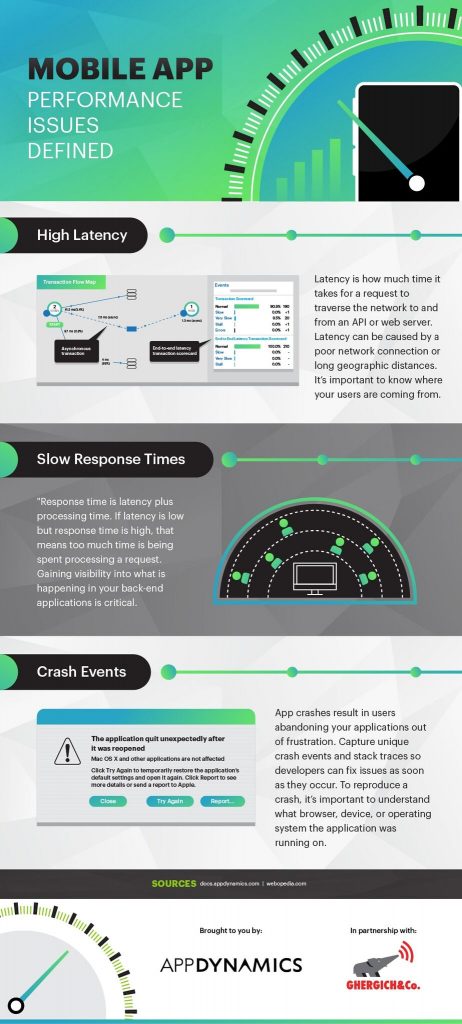3 Mobile App Performance Issues You Can’t Ignore
Discover faster, more efficient performance monitoring with an enterprise APM product learning from your apps. Take the AppDynamics APM Guided Tour!
With the mobile era upon us, the way we conduct business or communicate with our friends and family has changed significantly. Thanks to smartphones and tablets, we rely on mobile apps more and more. Because of this, mobile apps are big business. In fact, in 2016 alone the estimated global mobile app revenue was $88.3 billion. Whether we use apps to stay on top of projects, communicate with our team members, or relax while playing a game, there is an app for almost everything.
The Apple App store boasts close to 2 million apps, while Google Play has more than 2.2 million apps. With so much competition, if you focus on downloads or sales rather than performance, pretty soon you won’t have a chance to worry about either. While an appealing interface and a smooth user experience are important, they won’t matter much if your mobile app isn’t performing well. That’s why the surface level metrics shouldn’t be the only thing you pay attention to. If you want a successful app, there are a few other vital performance metrics you need to monitor.
End-to-End Latency
When it comes to mobile apps, speed is the absolute most crucial factor. It can make or break your business. If your app is slow, people will delete it; research shows that 59 percent of users dislike a slow launch and expect apps to open within two seconds.
A well-developed API can greatly improve the performance of your app in terms of speed, but measuring the API latency is not enough to get the full picture.
You also need to track the end-to-end response time for applications that power the APIs used. Generally, you’ll want to aim for a one-second response time and ensure you use standardized APIs to minimize the risk of increased latency. Run any needed updates as soon as possible so you can leverage potential improvements.
User Sessions
User sessions refer to the time, from the moment it’s opened to when it’s closed, that each user spends using the app. The average time a user spends in an app varies between from 7.55 minutes in gaming apps to 2.61 minutes in technology apps. The goal should be to aim for longer session lengths, but you can and should also monitor session intervals between each use of the app (which shows how often your app is used).
While user sessions aren’t exactly a performance problem, they can affect performance. If their location is too far away from the server or if they have a poor network connection, it can negatively affect app latency.
This metric can also give you insight on user engagement and help you identify ways to improve the frequency with which users interact with your app. According to AppsFlyer, only 3.3 percent of Android apps and 3.2 percent of iOS apps still had active users after a 30-day period. A great way to increase the number of user sessions is to create a reason for the app to become a part of people’s daily routines.
Contextual push notifications can help encourage users to come back to the app sooner rather than later. You can also develop a compelling offer or discount and updates on new features via email to encourage users to come back to the app. To promote a sense of urgency, create a time limit for the availability of discounts and special offers.
Crash Handling
Crashes drive users away, so keeping track of how often your app crashes is essential to improve its performance and ensure a smooth user experience.
Crash rate is measured as the average crashes every time an app launches. It’s usually somewhere between 1 to 2 percent; however, a number of factors—such as type of app, its usage, and maturity—can influence the crash rate.
In order to fully understand why a crash happened, you need to know what the user was doing when the app crashed, how many individual users were affected by the crash, and how different types of crashes impact your app.
Of course you should try to keep crashes to a minimum. Only 16 percent of users will try a failing app twice. The best way to achieve this is to continually test your app during development to identify potential problems. Start with a small group of testers and increase it so you can catch as many problems as possible before the launch. You can continue to test the app even after you launch, especially when more features are added or updated.
Don’t forget to prioritize the crashes so you can respond to the ones that need critical resolution first.
Improve Your App’s Chances of Success
In today’s world, it only takes a few moments before your users decide whether they enjoy your app or not. Monitor the performance of your app and ensure you have a proper way of collecting data so you can provide users with the best possible experience. Then you’ll be well on your way to success.
Discover faster, more efficient performance monitoring with an enterprise APM product learning from your apps. Take the AppDynamics APM Guided Tour!





